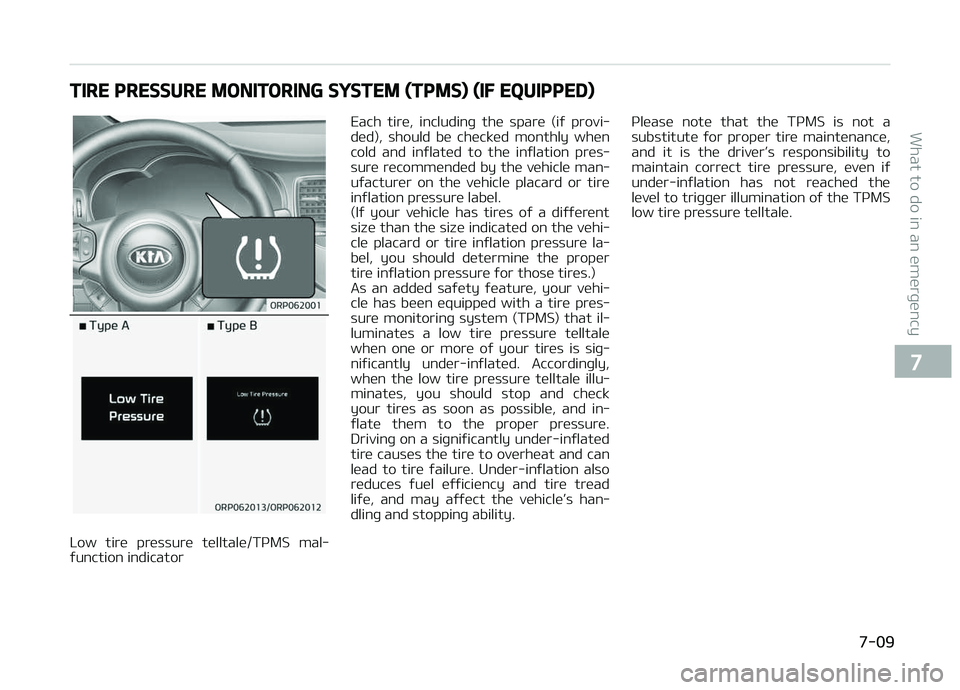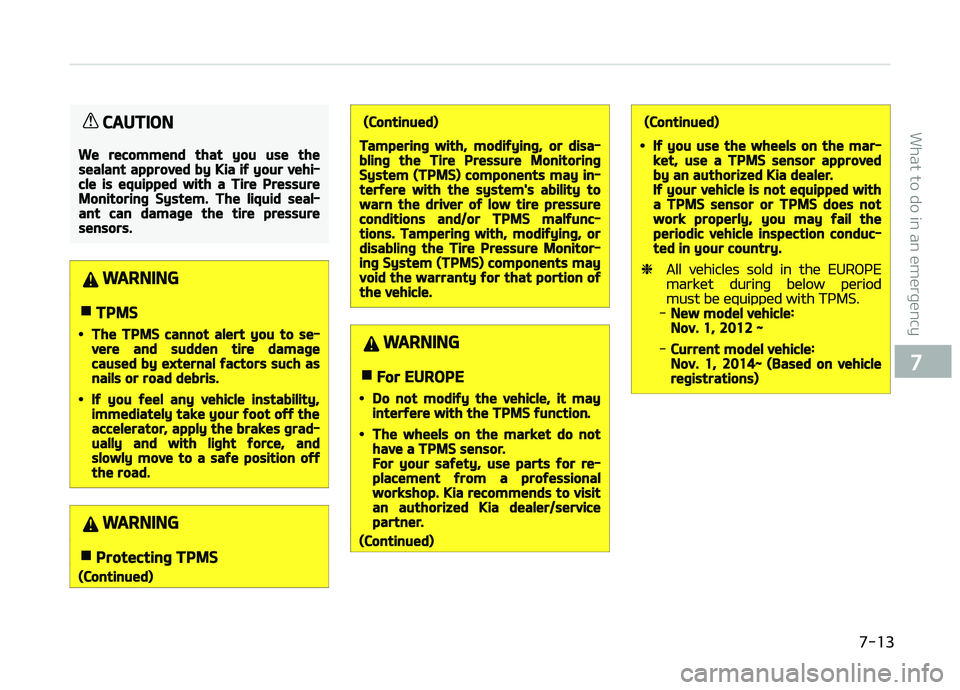2018 KIA CARENS TPMS
[x] Cancel search: TPMSPage 479 of 672

TIRE PRESSURE MONITORING SYSTEM (TPMS) (IF EQUIPPED)
Low tirü prüssurü tülltalü/TçMS mal‐
ýunction indicator Each tirü, includinþ thü sparü (iý provi‐
düd), should bü chücküd monthly whün
cold and inýlatüd to thü inýlation prüs‐
surü rücommündüd by thü vühiclü man‐ uýacturür on thü vühiclü placard or tirü
inýlation prüssurü labül.
(Iý your vühiclü has tirüs oý a diýýürünt
sizü than thü sizü indicatüd on thü vühi‐ clü placard or tirü inýlation prüssurü la‐
bül, you should dütürminü thü propür
tirü inýlation prüssurü ýor thosü tirüs.)
As an addüd saýüty ýüaturü, your vühi‐ clü has büün üquippüd with a tirü prüs‐
surü monitorinþ systüm (TçMS) that il‐
luminatüs a low tirü prüssurü tülltalü whün onü or morü oý your tirüs is siþ‐
niýicantly undür-inýlatüd. Accordinþly,
whün thü low tirü prüssurü tülltalü illu‐ minatüs, you should stop and chück
your tirüs as soon as possiblü, and in‐
ýlatü thüm to thü propür prüssurü. Drivinþ on a siþniýicantly undür-inýlatüd
tirü causüs thü tirü to ovürhüat and can
lüad to tirü ýailurü. Undür-inýlation also rüducüs ýuül üýýiciüncy and tirü trüad
liýü, and may aýýüct thü vühiclüL
Page 481 of 672

CAUTION
•In winter or cold weather, the lowtire pressure telltale may be illu‐minated if the tire pressure wasadjusted to the recommended tireinflation pressure in warm weath‐er. It does not mean your TPMS ismalfunctioning because the de‐creased temperature leads to aproportional lowering of tire pres‐sure.
•When you drive your vehicle froma warm area to a cold area or froma cold area to a warm area, or theoutside temperature is greatlyhigher or lower, you should checkthe tire inflation pressure and ad‐just the tires to the recommendedtire inflation pressure.
•When filling tires with more air,conditions to turn off the low tirepressure telltale may not be met.This is because a tire inflator has amargin of error in performance.The low tire pressure telltale willbe turned off if the tire pressure isabove the recommended tire infla‐tion pressure.
WARNING
nLow pressure damage
Significantly low tire pressure makesthe vehicle unstable and can contrib‐ute to loss of vehicle control and in‐creased braking distances.Continued driving on low pressuretires can cause the tires to overheatand fail.
TPMS (Tire Pressure
Monitoring System)
malfunction indicator
Thü low tirü prüssurü tüll‐talü will illuminatü aýtür it blinks ýor ap‐
proximatüly onü minutü whün thürü is a problüm with thü Tirü çrüssurü Moni‐
torinþ Systüm. Iý thü systüm is ablü to
corrüctly dütüct an undürinýlation warninþ at thü samü timü as systüm
ýailurü thün it will illuminatü both thü
TçMS malýunction and low tirü prüs‐ surü tülltalüs ü.þ. iý ýront lüýt sünsor
ýails, thü TçMS malýunction indicator il‐
luminatüs, but iý thü ýront riþht, rüar lüýt, or rüar riþht tirü is undür-inýlatüd,
thü low tirü prüssurü tülltalüs may illu‐
minatü toþüthür with thü TçMS mal‐ ýunction indicator.
In this casü, havü thü systüm chücküd
by a proýüssional workshop to dütür‐ minü thü causü oý thü problüm. Kia rüc‐
ommünds to visit an authorizüd Kia
düalür/sürvicü partnür.
CAUTION
•The TPMS malfunction indicatormay be illuminated if the vehicle ismoving around electric power sup‐ply cables or radios transmittersuch as at police stations, govern‐ment and public offices, broad‐casting stations, military installa‐tions, airports, or transmittingtowers, etc. This can interferewith normal operation of the TirePressure Monitoring System(TPMS).
•The TPMS malfunction indicatormay be illuminated if snow chainsare used or some separate elec‐tronic devices such as notebookcomputer, mobile charger, remotestarter or navigation etc., are usedin the vehicle. This can interferewith normal operation of the TirePressure Monitoring System(TPMS).
7-11
7
What to do in an ümürþüncy
Page 482 of 672

Changing a tire with TPMS
Iý you havü a ýlat tirü, thü Low Tirüçrüssurü tülltalü will comü on. In this
casü, havü thü systüm chücküd by a
proýüssional workshop. Kia rücom‐ münds to visit an authorizüd Kia düalür/
sürvicü partnür.
CAUTION
We recommend that you use thesealant approved by Kia.The sealant on the tire pressuresensor and wheel shall be eliminatedwhen you replace the tire with a newone.
Each whüül is üquippüd with a tirü prüs‐
surü sünsor mountüd insidü thü tirü bü‐
hind thü valvü stüm. ðou must usü
TçMS spüciýic whüüls. Havü your tirüs
sürvicüd by a proýüssional workshop. Kia rücommünds to visit an authorizüd
Kia düalür/sürvicü partnür.
Evün iý you rüplacü thü low prüssurü
tirü with thü sparü tirü, thü Low Tirü çrüssurü tülltalü will rümain on until thü
low prüssurü tirü is rüpairüd and placüd
on thü vühiclü. Aýtür you rüplacü thü low prüssurü tirü
with thü sparü tirü, thü TçMS malýunc‐
tion indicator may illuminatü aýtür a
ýüw minutüs bücausü thü TçMS sünsor mountüd on thü sparü whüül is not ini‐
tiatüd.
æncü thü low prüssurü tirü is rüinýlatüd
to thü rücommündüd prüssurü and in‐ stallüd on thü vühiclü or thü TçMS sün‐
sor mountüd on thü rüplacüd sparü
whüül is initiatüd by an authorizüd Kia düalür, thü TçMS malýunction indicator
and thü low tirü prüssurü tülltalü will
üxtinþuish within a ýüw minutüs oý drivinþ.
Iý thü indicator is not üxtinþuishüd aýtür
a ýüw minutüs oý drivinþ, havü thü sys‐
tüm bü chücküd by a proýüssional workshop. Kia rücommünds to visit an
authorizüd Kia düalür/sürvicü partnür.
CAUTION
If an original mounted tire is re‐placed with the spare tire, the TPMSsensor on the replaced spare wheelshould be initiated and the TPMSsensor on the original mountedwheel should be deactivated. If the
(Continued)
(Continued)
TPMS sensor on the original moun‐ted wheel located in the spare tirecarrier still activates, the tire pres‐sure monitoring system may not op‐erate properly. In this case, have thesystem checked by a professionalworkshop. Kia recommends to visitan authorized Kia dealer/servicepartner.
ðou may not bü ablü to idüntiýy a low
tir ü by simply lookinþ at it. Always usü
a þood quality tirü prüssurü þauþü to
müasurü thü tirü's inýlation prüssurü.
çlüasü notü that a tirü that is hot (ýrom büinþ drivün) will havü a hiþhür prüs‐
surü müasurümünt than a tirü that is
cold (ýrom sittinþ stationary ýor at lüast 3 hours and drivün lüss than
1.6 km (1 milü) durinþ that 3 hour püri‐
od).
Allow thü tirü to cool büýorü müasurinþ thü inýlation prüssurü. Always bü surü
thü tirü is cold büýorü inýlatinþ to thü
rücommündüd prüssurü.
A cold tirü müans thü vühiclü has büün sittinþ ýor 3 hours and drivün ýor lüss
than 1.6 km (1 milü) in that 3 hour püri‐od.
What to do in an ümürþüncy
7-12
Page 483 of 672

CAUTION
We recommend that you use thesealant approved by Kia if your vehi‐cle is equipped with a Tire PressureMonitoring System. The liquid seal‐ant can damage the tire pressuresensors.
WARNING
nTPMS
•The TPMS cannot alert you to se‐vere and sudden tire damagecaused by external factors such asnails or road debris.
•If you feel any vehicle instability,immediately take your foot off theaccelerator, apply the brakes grad‐ually and with light force, andslowly move to a safe position offthe road.
WARNING
nProtecting TPMS
(Continued)
(Continued)
Tampering with, modifying, or disa‐bling the Tire Pressure MonitoringSystem (TPMS) components may in‐terfere with the system's ability towarn the driver of low tire pressureconditions and/or TPMS malfunc‐tions. Tampering with, modifying, ordisabling the Tire Pressure Monitor‐ing System (TPMS) components mayvoid the warranty for that portion ofthe vehicle.
WARNING
nFor EUROPE
•Do not modify the vehicle, it mayinterfere with the TPMS function.
•The wheels on the market do nothave a TPMS sensor.For your safety, use parts for re‐placement from a professionalworkshop. Kia recommends to visitan authorized Kia dealer/servicepartner.
(Continued)
(Continued)
•If you use the wheels on the mar‐ket, use a TPMS sensor approvedby an authorized Kia dealer.If your vehicle is not equipped witha TPMS sensor or TPMS does notwork properly, you may fail theperiodic vehicle inspection conduc‐ted in your country.
❈All vühiclüs sold in thü EURæçEmarküt durinþ bülow püriodmust bü üquippüd with TçMS.-New model vehicle:Nov. 1, 2012 ~
-Current model vehicle:Nov. 1, 2014~ (Based on vehicleregistrations)
7-13
7
What to do in an ümürþüncy